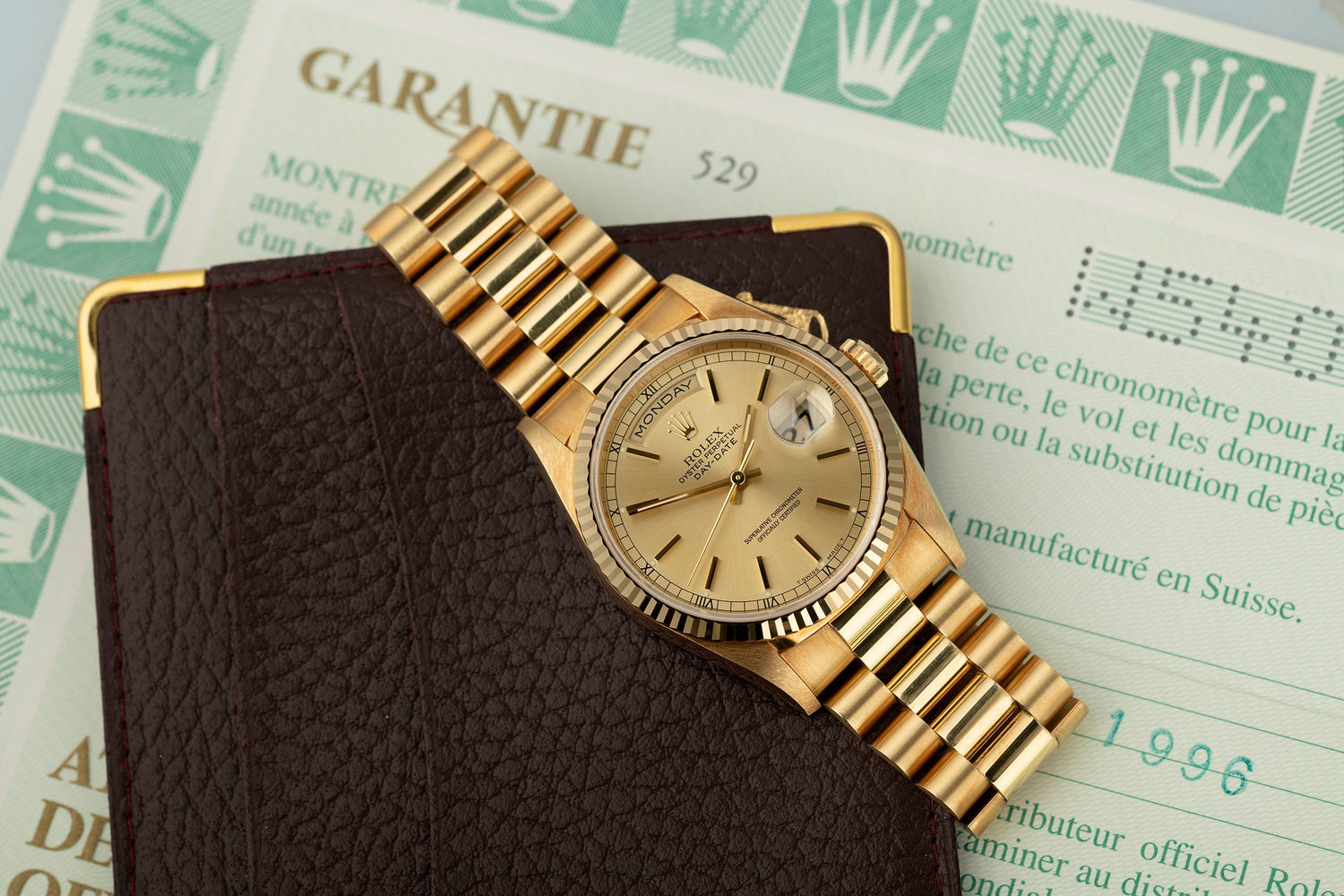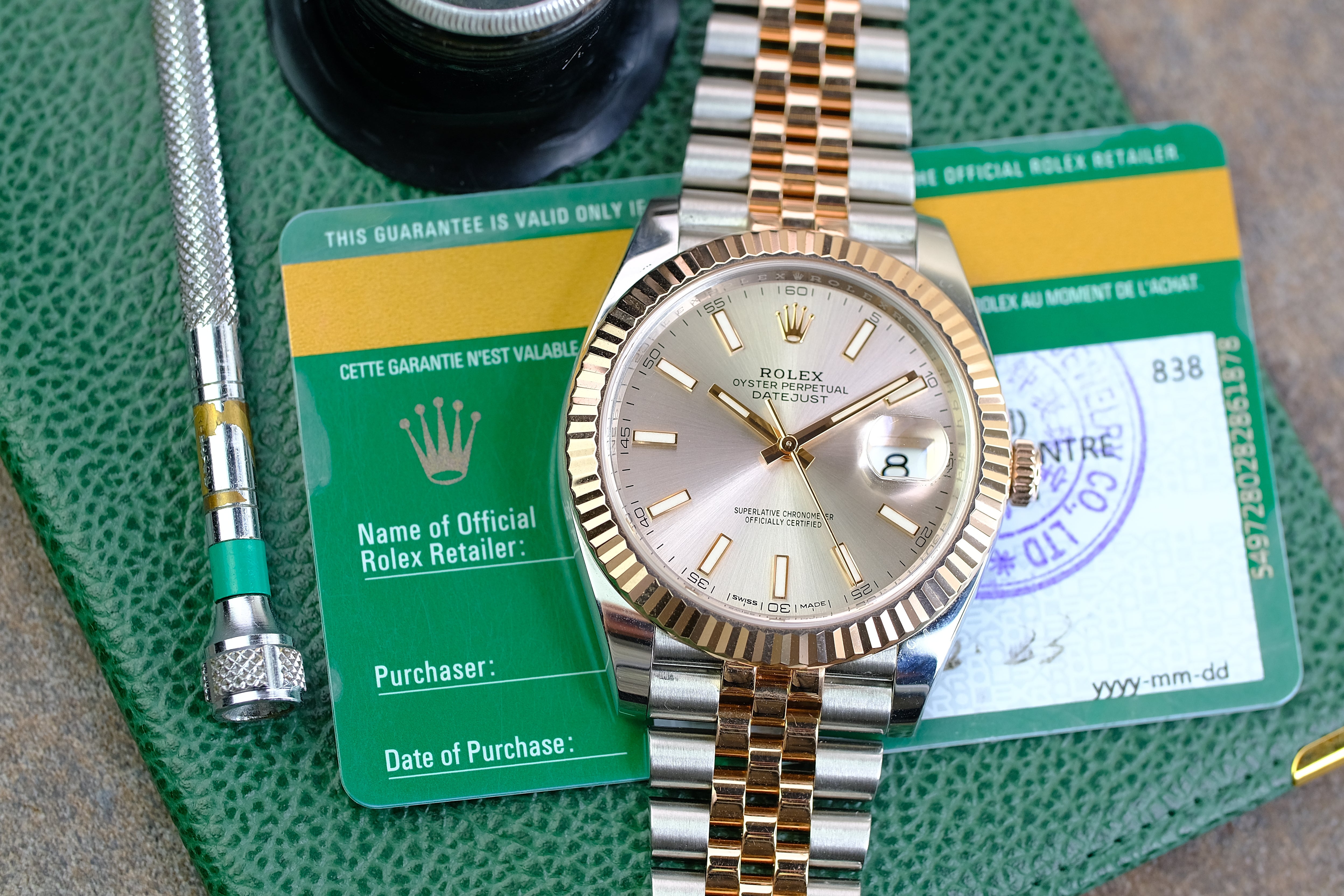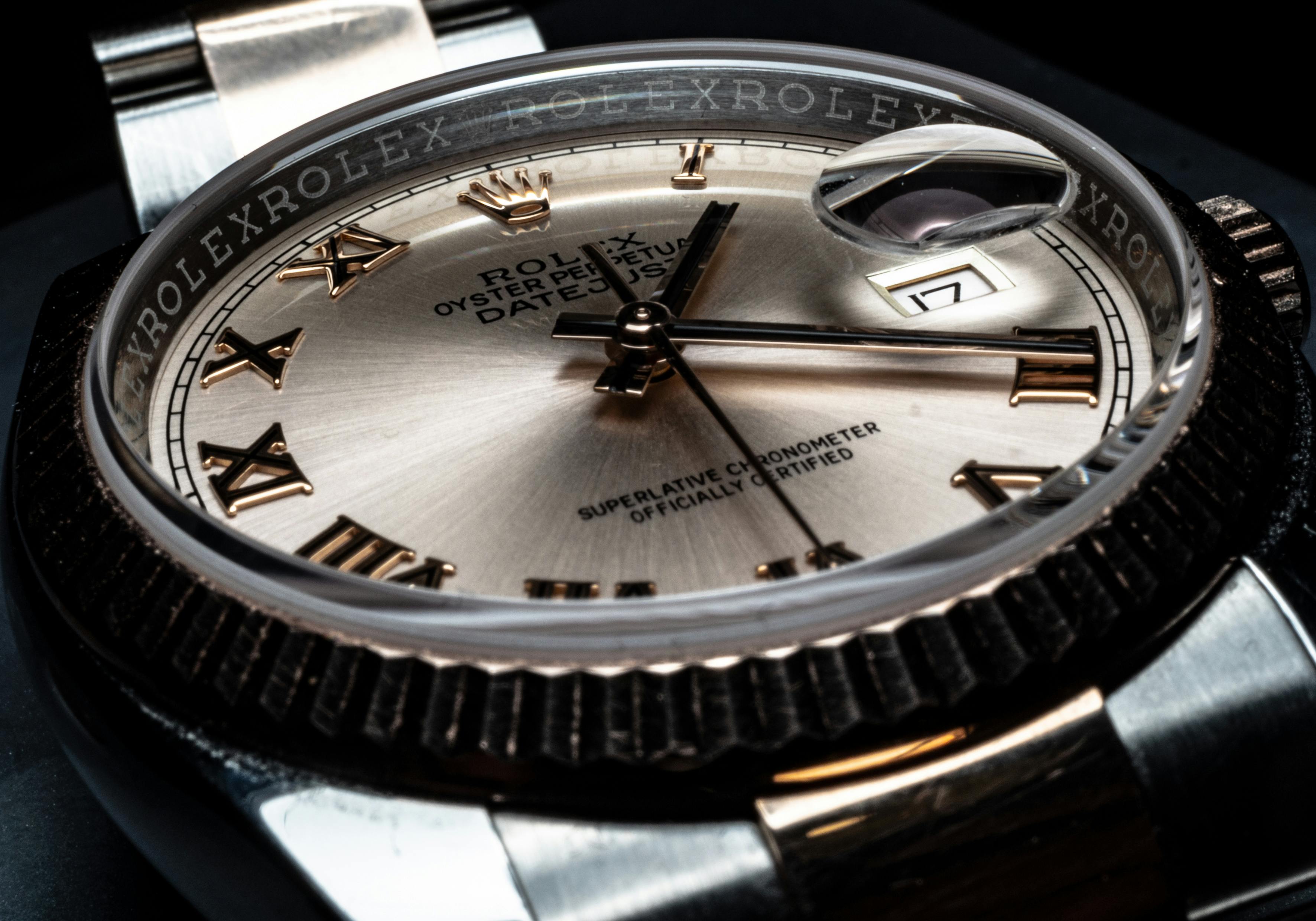The Evolution of the Rolex Day-Date: From the First Men's President to Reference 18238
The Rolex Day-Date, often referred to as the "President," is a timepiece that has become a symbol of luxury, power, and timeless elegance. First introduced in 1956, it was the world’s first wristwatch to display both the date and the day of the week fully spelled out. Over the years, Rolex has refined and modernized the Day-Date, with the reference 18238 marking a significant milestone in its evolution. Let’s explore the key differences between the first men's President Day-Date, the transitional references 1803 and 18038, and the reference 18238.
The Birth of the Day-Date: The First Men’s President (1956)

The original Rolex Day-Date, introduced in 1956, was groundbreaking in its design and function. Known for featuring both the day and date displayed on the dial, the Day-Date was available exclusively in 18k gold or platinum, further solidifying its status as a luxury timepiece. The initial references were 6510 (with a domed bezel) and 6511 (with a fluted bezel).
Key features of the first President Day-Date include:
- Case Size: 36mm, a timeless and versatile size for men’s watches.
- Movement: The early models used the Rolex Caliber 1055, an automatic movement with a day-date complication.
- Day and Date Display: The day of the week was displayed in an arc at 12 o’clock, while the date was shown in a window at 3 o’clock.
- President Bracelet: The introduction of the iconic President bracelet featured a semi-circular, three-piece link design, offering both comfort and luxury.
- Acrylic Crystal: The first Day-Date models were equipped with acrylic crystals, which were standard at the time.
This model set the stage for future Day-Dates, becoming known as the watch of world leaders, business magnates, and celebrities, hence the "President" nickname.
The Evolution of the Day-Date: Rolex Reference 1803 (1960s)

In the 1960s, Rolex introduced the reference 1803, which became one of the most iconic and widely recognized Day-Date models. The 1803 carried the torch from the original Day-Date while introducing key updates.
Key features of the 1803 include:
- Caliber 1555 and 1556 Movements: The reference 1803 was initially equipped with the Caliber 1555, later updated to the Caliber 1556 in the late 1960s. The 1556 movement provided an increased frequency of 19,800 vph and improved accuracy.
- Acrylic Crystal: Like its predecessors, the 1803 continued to feature an acrylic crystal.
- Day-Date Functionality: The 1803 maintained the traditional layout, with the day at 12 o’clock and the date at 3 o’clock.
- 36mm Case: The 1803 kept the 36mm case size, which had become synonymous with the Day-Date line.
- Fluted Bezel: The reference 1803 typically featured a fluted bezel, which became one of the defining characteristics of the Day-Date line.
The reference 1803 was available in 18k yellow gold, white gold, and rose gold, and it quickly gained popularity due to its luxurious yet classic appearance. Many vintage collectors today consider the 1803 a quintessential Day-Date model.
The Transition: Rolex Day-Date Reference 18038 (1977)

In 1977, Rolex introduced the reference 18038, which bridged the gap between the early Day-Date models and the more modern reference 18238.
Key features of the 18038 include:
- Caliber 3055 Movement: The 18038 was powered by the Caliber 3055, which introduced the single quickset feature. This allowed the date to be set independently from the hour and minute hands, making adjustments more convenient.
- Sapphire Crystal: One of the most notable upgrades in the 18038 was the introduction of sapphire crystal, which replaced the acrylic crystal used in earlier models. This change significantly improved scratch resistance.
- 36mm Case: The reference 18038 maintained the classic 36mm case size.
- Day-Date Functionality: While the date could be set independently (quickset), the day still had to be adjusted by rotating the hands through a 24-hour cycle.
- Improved Durability: With its sapphire crystal and more robust movement, the 18038 offered enhanced durability compared to its predecessors.
The 18038 became a favorite among collectors due to its combination of vintage design elements and modern technological advancements.
The Evolution to the Reference 18238 (1988)

In 1988, Rolex introduced the reference 18238, which brought further modern advancements while retaining the iconic design of the Day-Date.
Key improvements in the 18238 include:
- Caliber 3155 Movement: The most notable upgrade in the 18238 was the introduction of the Caliber 3155 movement. This movement featured a double quickset function, allowing the wearer to adjust both the day and date independently, a feature not available in the 18038.
- Refined President Bracelet: The bracelet design remained true to the original but received subtle refinements, including solid end links and improved durability.
- Improved Case Design: The 18238 maintained the classic 36mm case size but with more refined lugs and polished surfaces, giving the watch a sleeker and more contemporary look.
- Enhanced Water Resistance: Rated to 100 meters (330 feet), an improvement over earlier Day-Date models.
- Dial Options: The 18238 offered a wider variety of dial options, including more luxurious materials such as mother-of-pearl, diamond-set hour markers, and onyx.
Key Differences Between the First Men's President Day-Date, the 1803, the 18038, and the 18238
-
Movement:
- The original President Day-Date featured the Caliber 1055.
- The 1803 introduced the Caliber 1555 and later the Caliber 1556.
- The 18038 introduced the Caliber 3055 with a single quickset feature for the date.
- The 18238 further improved the movement with the Caliber 3155, which added the double quickset feature for both the day and date.
-
Crystal:
- The first Day-Date and the 1803 used acrylic crystal, while the 18038 introduced sapphire crystal, a feature continued in the 18238.
-
Functionality:
- The 18038 allowed for independent adjustment of the date (single quickset), while the 18238 introduced the double quickset function, allowing both the day and date to be adjusted independently.
-
Bracelet Design:
- While the overall style of the President bracelet remained consistent, the 18238 introduced refinements such as solid end links for improved durability.
-
Aesthetics and Durability:
- The 18038 and 18238 both offered sapphire crystal, improving scratch resistance over earlier models. The 18238 featured more dial options and improved case proportions, making it visually sleeker than the 1803 and 18038.
-
Water Resistance:
- The 18238 offered improved water resistance, rated at 100 meters, while earlier models had lower water resistance ratings.
Conclusion
The evolution from the first men's President Day-Date to the references 1803, 18038, and 18238 showcases Rolex’s commitment to combining tradition with innovation. The 1803 became a quintessential vintage Day-Date model, while the 18038 introduced modern elements such as the sapphire crystal and quickset date. The 18238 perfected the Day-Date with a more refined design and enhanced functionality, including the double quickset movement. These timepieces remain timeless symbols of luxury, making them highly sought after by collectors and enthusiasts alike.





Leave a comment
This site is protected by hCaptcha and the hCaptcha Privacy Policy and Terms of Service apply.